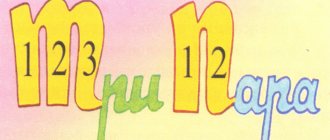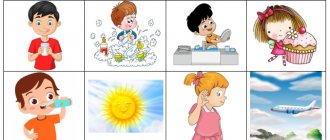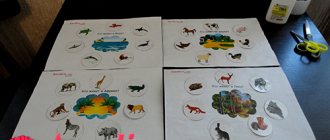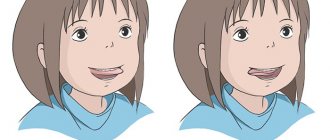§ 1 Agreement of an adjective with a noun Let's start the lesson with observation.
From the television program, we will write down three titles of television programs that include adjectives, and we will also remember and write down three titles of works of art that include adjectives.
I found the following names of TV shows: “Local Time”, “Traffic ABC”, “Wonders of the Solar System”, you will have to find other names that correspond to our task.
Of the titles of works of art, I propose to write down: “Mad Evdokia” (author of the story Anatoly Aleksin), the title of the story “Spring Changelings” (V. Tendryakov), the title of the story by V.A. Bakhrevsky "Dog in a Potato Field".
Let us determine the gender, number and case of nouns, which include adjectives, as well as the gender, number and case of adjectives.
Let's enter the obtained data into a table consisting of three columns, where
Column 1 is the name of works of art and television programs,
2nd - gender, number, case of the noun,
3rd - gender, number and case of the adjective.
Let's compare the results.
| Name | Gender, number, case of a noun | Gender, number and case of the adjective |
| "Local time" | time - av.r., units, i.p. | Local (n.f. - local) - used in the middle form, singular, i.p. |
| "Road ABC" | alphabet - zh.r., singular, i.p. | Dorozhnaya (n.f. - road) - used in w.r., singular, i.p. |
| "Wonders of the Solar System" | systems (n.f. - system) - zh.r., unit, r.p. | Solar (n.f. - sunny) - used in w.r., singular, r.p. |
| "Mad Evdokia" | Evdokia - zh.r., singular, in them. P. | Mad (n.f. - crazy) - used in f.r., singular, i.p. |
| "Spring Changelings" | shifters (n.f. - shifter) – m.r., plural, i.p. | Spring (n.f. - spring) - used in plural, i.p. The genus cannot be determined, because plural adjective |
| "Dog in a Potato Field" | (on) field (n.f. - field) - cf. r., unit, p.p. | potato (n.f. - potato) - used in Wed. r., unit, p.p. |
What conclusion can be drawn?
By naming the characteristics of objects, adjectives explain nouns, therefore the morphological characteristics of the adjective help it adapt to the noun.
Adjectives agree with nouns in gender, number and case, i.e. have the same gender, number and case as nouns. If the noun is feminine, then the adjective takes the feminine form (road alphabet), if the noun is used in the prepositional case, then the adjective is used in the same case (in the potato field), if the noun is in the plural form, then the adjective takes the form plural: spring shifters.
Adjectives change according to gender, number and case. Even in the most complex cases, the adjective tells us the gender of the noun.
For example,
valuable parcel (adjective valuable in the feminine gender),
spacious lobby (masculine adjective spacious).
What if the noun is unchangeable? Cockatoo, coat, chimpanzee, penalty. Again, the adjective comes to the rescue, because by its form you can determine the gender of an unchangeable noun:
decisive penalty adjective in m.p.,
fashionable coat adjective,
funny cockatoo adjective in m.p.,
caring chimpanzee adjective in female form, here we are talking about a female chimpanzee.
In the plural, the gender of the adjective does not differ: spring shifters, spring birds, spring trees. Regardless of the gender of the noun in the singular (shifter, bird, tree), the form of the adjective is the same (spring).
Didactic games for children 5-7 years old. Topic: "Adjective"
Didactic games for introducing and reinforcing the topic “Adjective”.
Dear colleagues!
My name is Yana Stanislavovna Averyanova, I am a preparatory group teacher at a Montessori play school. Today I want to present to you material from the “language” section, which I developed based on the three-hour cards of M. Montessori. A lot of linguistic material exists in the Montessori system, which was adapted to the peculiarities of our native language by a follower of Montessori in Russia, Yu.I. Fausek. Arranging the words of a language according to certain characteristics is the main way to deepen and expand a child’s linguistic intuition. Not learning certain grammatical rules and applying them in written and spoken speech, but training in the intuitive comparison of words according to certain parameters specified in the grammatical material. Y.I. Fausek said that the conscious study of Russian grammar from the age of 5-6 should begin with their intuitive determination of the gender and number of nouns. And when children have mastered such grammatical units as “noun”, “gender”, “number”, they can begin to study other parts of speech. And the first one will be “Adjective”. Before starting to work with the material, the child must be introduced to this part of speech. It is not necessary to give a concept, but the child should already know what question this part of speech answers and that it denotes a feature of an object; for this, in Montessori pedagogy, the “Farm” manual is used, but you can also use what is at hand, for example: There are a lot of pencils laid out on the table and the teacher asks: -Give me a pencil.
(the child brings any pencil he likes) - No, you brought me the wrong pencil, I need another one. Since there are a lot of pencils, the child is at a loss and naturally the question arises - which one? -Blue. The child hands over a pencil and the teacher says: -Name the question you asked me. (WHAT?) -What pencil did you bring me? -To the question, which one? the adjective answers. (the child repeats the name of the part of speech after the teacher and tries to remember) - What do you think the adjective means? (this question can cause difficulty and therefore the teacher can ask the child to speculate: can a pencil only be blue? This means that the pencil remains unchanged, but its color changes. Color is a sign of a pencil by which we can recognize it among other similar pencils. Can only the color of a pencil change? What else? (shape, thickness, length). These are all signs by which we can distinguish identical objects from each other.) After this, knowledge is consolidated: -Ask a question about the word blue. -What part of speech is this and what does it mean? -Tell me all the signs by which this pencil can be recognized (color, shape, length, width) To consolidate the acquired knowledge, you can play the game “Detectives” (the teacher and the child take turns describing various objects that need to be guessed) In the Montessori system individual presentation lessons are practiced, but when the children are already familiar with the material (in this case with an adjective), you can also use group work - the game “Detectives” (the teacher asks the child to either find the object using the specified characteristics, or the child himself describes the object so that others guessed what object he described) - they name the characteristics of the object one by one (what kind of house could it be?) - what could be round? (square, soft.....) - name the adjectives that answer the question which? (which? Which?..) In order for the child to deepen and hone his knowledge and skills in identifying adjectives, I offer didactic games developed by me. Didactic game “Adjectives”
Objectives: Direct
: introduce children to the part of speech - adjective
Indirect:
Enrichment of vocabulary Development of attention, thinking, speech Teach children to classify adjectives Improvement of writing and reading skills Speech development
Material:
Three-part cards with adjectives (a control card (on which a picture and a word are combined) and cards with a separate picture and word).
Qualitative: purple, blue, light blue, green, yellow, orange, red, white, brown, black, grey, pink, sunny, rainy, fiery, rough, wavy, smooth, checkered, striped, spotted, multi-colored, ribbed, cloudy, square, pimply, colorful, fluffy, soft, silver, hard, round. Relative: paper, knitted, wood, denim, iron, stone, leather, ice, fur, plastic, snow, glass, scaly, rubber, brick, birch. Possessive: squirrel, fox, hare, wolf, horse, cow, bird, giraffe, goat, dog, cat, penguin, sheep, dolphin, ostrich, seal, turtle, chicken, crocodile, ostrich, quail, snake, duck, eagle. Age : 5-7 years Acquaintance can begin in the senior group of kindergarten (without division into qualitative, relative and possessive) and continue acquaintance in the preparatory group, already dividing these words into groups and drawing conclusions about how they differ from each other ( without giving concepts, on an intuitive level). The material can also be used in elementary school when getting acquainted with the topic “Adjectives” and in middle school, where they are getting acquainted with types of adjectives. Methods of checking: The teacher checks the correctness of the work, the child can check himself using a control card, or an older friend can check.
Getting to know the material.
A child in a Montessori group is already familiar with three-hour cards and the algorithm for working with it from the younger group: - control cards are laid out on a mat (you can also do it on a table, but it’s more convenient for children to work on a mat and there is more space) from the upper left corner down one after another, if they don’t all fit into one row, then the next row is lined up in the same way, from top to bottom, but not close to the first row, but at a distance so that a picture and a word can be placed next to each other (photo 1). -the child selects pictures that match the control cards (the child lays out all the pictures for the control cards) (photo 2) -the child selects all the words and places them under the pictures (if the child cannot read, then he selects the words according to the image - “intuitive reading”) ( photo 3) Card picture word To begin with, the child works with one set of cards (qualitative, relative, or possessive, it is better to start with qualitative ones, because it is closer to the child and easier to perceive). -When all the material is laid out, the child is asked to look at it and think about what all these pictures have in common, what groups it can be divided into (signs are indicated by color, shape, texture) -I rewrite the words in a notebook. -make up phrases and sentences with these words (you can compose a fairy tale or story using these adjectives) In high school, this material is used to teach the concept of qualitative adjectives, and children can draw conclusions based on what criteria adjectives can be attributed to this group. We work with the material on other types of adjectives in the same way.
Additional exercises:
-to complicate the work and practice the acquired knowledge, children first lay out pictures, then select words and then check the correctness of execution using a control card. -you can carry out group work with this material • Divide the cards into pockets on the board into qualitative, relative and possessive • Distribute cards to children and invite them to unite in groups by type of adjectives (raise your hands those who have qualitative adjectives, those whose adjectives denote color, those who whom adjectives answer the question whose?, etc.) • Play riddles: those children will stand whose word denotes the attribute of an object by the material from which it is made…. • Say the word: my ball...(children can stand up whose cards match the color, shape, texture, material: red, round, smooth, rubber) You can come up with other games, depending on the goals and purposes of using the material . photo 1
photo 2
photo 3
A continuation of the work on adjectives is another material “Noun + Adjective”, on the basis of which the correct agreement of these parts of speech is formed.
Didactic game “Noun + Adjective”
Objectives: Direct:
to teach children to agree nouns with adjectives in gender.
Indirect
: Development of attention, fine motor skills Enrichment and activation of vocabulary Development of coherent speech Improving reading and writing skills
Material:
Three-part cards.
Adjectives: colorful, spotted, checkered, lilac, yellow, red, green (I took only high-quality adjectives, but in the future you can use both relative and possessive when the child has mastered working with this material well enough). The border of the cards is blue and next to the word is a blue triangle - a symbol of an adjective in the Montessori system. Control card only. Nouns: M.r. - jug, umbrella, ball, elephant, flower. F. R. - shirt, pan, hat, butterfly, vase. Wed. r. - gun, towel, bucket, coat, dress. The border of the cards is black and next to the word there is a black triangle - a symbol of a noun in Montessori. All pictures of nouns are black and white. Endings are highlighted in the inscriptions. Control card only. Coordination: colorful jug, spotted jug, checkered jug, purple jug, yellow jug, red jug, green jug; colorful umbrella, spotted umbrella, checkered umbrella, purple umbrella, yellow umbrella, red umbrella, green umbrella; colorful ball, spotted ball, checkered ball, purple ball, yellow ball, red ball, green ball; colorful elephant, spotted elephant, checkered elephant, purple elephant, yellow elephant, red elephant, green elephant; colorful flower, spotted flower, checkered flower, lilac flower, yellow flower, red flower, green flower; colorful shirt, spotted shirt, plaid shirt, purple shirt, yellow shirt, red shirt, green shirt; colorful pan, spotted pan, checkered pan, purple pan, yellow pan, red pan, green pan; colorful hat, spotted hat, checkered hat, lilac hat, yellow hat, red hat, green hat; colorful butterfly, spotted butterfly, checkered butterfly, lilac butterfly, yellow butterfly, red butterfly, green butterfly; colorful vase, spotted vase, checkered vase, lilac vase, yellow vase, red vase, green vase; colorful gun, spotted gun, checkered gun, purple gun, yellow gun, red gun, green gun; colorful towel, spotted towel, checkered towel, purple towel, yellow towel, red towel, green towel; colorful bucket, spotted bucket, checkered bucket, purple bucket, yellow bucket, red bucket, green bucket; colorful coat, spotted coat, checkered coat, lilac coat, yellow coat, red coat, green coat; colorful dress, spotted dress, checkered dress, lilac dress, yellow dress, red dress, green dress. The matching cards have a black border, the endings of nouns and adjectives are highlighted in red (color highlighting will help you draw a conclusion about the change in ending depending on the gender and make a conclusion based on the gender endings of nouns and adjectives). For coordination, not only three-hour cards are needed, but also separate cards with words, so that in the future the child can make pairs to agree on a noun and an adjective without relying on visualization. Symbols of parts of speech: black and blue triangles (when children make up phrases on their own, the symbols indicate the part of speech) All cards are divided into separate envelopes or boxes (5 pieces), in each of which: - 3 cards with a noun (m.r., f. .r., sr.r.) - cards with adjectives - cards for agreeing these nouns with an adjective - cards with words Age : 6-7 years You can start working with cards in the preparatory group of kindergarten and continue in elementary school during the study period topic “Agreeing a noun with an adjective.”
Verification methods:
A child can check himself using a control card, a teacher checks, a child who has a sufficient command of the material checks.
Getting to know the material:
The teacher takes one of the envelopes and invites the child to introduce him to the new material. Then he lays out the cards, starting from the upper left corner. First, he lays out the cards on the noun from top to bottom (PHOTO 1). -What do these cards have in common? (these are cards with nouns) Then he lays out the control cards on adjectives from left to right (photo 2). -Look carefully at the cards, what do they have in common? (all cards are for the name adjective) -Now we will select cards when nouns are combined with adjectives (the teacher shows the first 3 agreements and asks the child to continue independently; if the child has difficulties, then continue working together). First, control cards are laid out, and then pictures and words are selected. If the child already knows how to read, he reads all the resulting phrases, if not, then he pronounces all the phrases based on clarity, selects words according to the image - “intuitive reading” (photo 3, 4, 5). When all the cards are laid out, the teacher draws attention to the masculine noun and its ending: - the endings of words are highlighted in red. What are the endings for adjectives with the word umbrella? What gender does the word umbrella belong to? -What conclusion can be drawn? We also work with feminine and neuter endings. Gradually the child works through all the cards in all 5 envelopes.
Additional exercises
- when the child is already working well enough with the material, you can invite him to work without control cards, that is, immediately select a picture and words. - you can remove the control cards of nouns and adjectives and make up phrases (picture-word) yourself - to complicate the work, there are cards with words that children select into pairs independently based on the experience gained from working with the cards - come up with your own phrases You can offer group work: - some of the children receive cards with nouns, and the rest - with adjectives and “go to visit each other” - they unite in pairs and pronounce the resulting phrases - cards with nouns are attached to the board and chips are distributed to the children - attach the chip to the noun that can be colorful, red, lilac. Photo 1
photo 2
Photo 3
photo 4
Photo 5
Maybe someone will be surprised that I offer such work for preschoolers, but, working according to the M. Montessori system, I was convinced that children can master many grammatical categories already in kindergarten.
I hope that my work will be interesting and useful to my colleagues. Literature: “Russian grammar according to the Montessori method” Y. Fausek, St. Petersburg 2011
We recommend watching:
Didactic games for children 5-7 years old: Winter sports Educational game for children 4-7 years old: “Magic bag of cards” Didactic game for social and communicative development for children of the senior group Games for speech development in the senior group of kindergarten
Similar articles:
Assignments on the topic “Forest” for children 6-8 years old
Methods of using didactic games in kindergarten in the senior preparatory group
What is the game like?
Hello! My name is Lampobot, I am a computer program that helps you make Word Maps. I can count perfectly, but I still don’t understand very well how your world works. Help me figure it out!
Thank you!
I began to understand the world of emotions a little better.
Question: beat up
- is it something neutral, positive or negative?
Neutral Positive Negative I don’t know
Associations to the word “game”
Synonyms for the word "game"
Sentences containing "game"
- He looks at the textbook and dreams about how he will play the new computer game
that was given to him yesterday for his birthday.
Quotes from Russian classics with the word “game”
- Several generals and privy councilors played whist [Whist is a team card game
, the predecessor of bridge and poker.
The meaning of the word "game"
GAME, -y, plural.
games, games,
w.
1.
Action according to verb.
play (in 1 value). (Small Academic Dictionary, MAS)
Aphorisms of Russian writers with the word “game”
- - a fiend of the mind and spirit, a special kind of special illness, - and you can’t be disappointed in her...
Submit Comment
Additionally
see also
The meaning of the word "game"
GAME, -y, plural.
games, games,
w.
1.
Action according to verb.
play (in 1 value).






